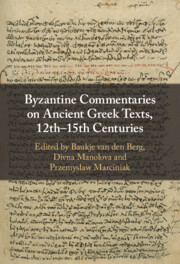Book contents
- Byzantine Commentaries on Ancient Greek Texts, 12th–15th Centuries
- Byzantine Commentaries on Ancient Greek Texts, 12th–15th Centuries
- Copyright page
- Contents
- Contributors
- Introduction Byzantine Commentaries on Ancient Greek Texts
- Chapter 1 The Politics and Practices of Commentary in Komnenian Byzantium
- Chapter 2 Forging Identities between Heaven and Earth
- Chapter 3 Cultural Appropriation and the Performance of Exegesis in John Tzetzes’ Scholia on Aristophanes
- Chapter 4 Uncovering the Literary Sources of John Tzetzes’ Theogony
- Chapter 5 Odysseus the Schedographer
- Chapter 6 Eustathios of Thessalonike on Comedy and Ridicule in Homeric Poetry
- Chapter 7 Geography at School
- Chapter 8 Painting and Polyphony
- Chapter 9 Parodying Antiquity for Pleasure and Learning
- Chapter 10 Teaching Poetry in the Early Palaiologan School
- Chapter 11 Late Byzantine Scholia on the Greek Classics
- Chapter 12 Theodora Raoulaina’s Autograph Codex Vat. gr. 1899 and Aelius Aristides
- Chapter 13 The Reception of Eustathios of Thessalonike’s Parekbolai in Arsenios Apostolis’ and Erasmus’ Paroemiographic Collections
- Index
- References
Chapter 10 - Teaching Poetry in the Early Palaiologan School
Manuel Holobolos’ and John Pediasimos’ Commentaries on Theocritus’ Syrinx
Published online by Cambridge University Press: 07 August 2023
- Byzantine Commentaries on Ancient Greek Texts, 12th–15th Centuries
- Byzantine Commentaries on Ancient Greek Texts, 12th–15th Centuries
- Copyright page
- Contents
- Contributors
- Introduction Byzantine Commentaries on Ancient Greek Texts
- Chapter 1 The Politics and Practices of Commentary in Komnenian Byzantium
- Chapter 2 Forging Identities between Heaven and Earth
- Chapter 3 Cultural Appropriation and the Performance of Exegesis in John Tzetzes’ Scholia on Aristophanes
- Chapter 4 Uncovering the Literary Sources of John Tzetzes’ Theogony
- Chapter 5 Odysseus the Schedographer
- Chapter 6 Eustathios of Thessalonike on Comedy and Ridicule in Homeric Poetry
- Chapter 7 Geography at School
- Chapter 8 Painting and Polyphony
- Chapter 9 Parodying Antiquity for Pleasure and Learning
- Chapter 10 Teaching Poetry in the Early Palaiologan School
- Chapter 11 Late Byzantine Scholia on the Greek Classics
- Chapter 12 Theodora Raoulaina’s Autograph Codex Vat. gr. 1899 and Aelius Aristides
- Chapter 13 The Reception of Eustathios of Thessalonike’s Parekbolai in Arsenios Apostolis’ and Erasmus’ Paroemiographic Collections
- Index
- References
Summary
Theocritus’ Syrinx is one of the Technopaegnia, a corpus of Hellenistic and Roman calligrames with an intricate and enigmatic vocabulary. The Palaiologan scholars Maximos/Manuel Holobolos and John Pediasimos rediscovered this poem and composed commentaries for didactic purposes. The first part of this chapter delves deeper into the teaching of Holobolos, who has not received as much attention as other Palaiologan scholars. With a particular focus on his commentary on the Syrinx, it analyses Holobolos’ work on the Technopaegnia and addresses questions such as: Why was Holobolos interested in these poems? Which sources did he employ and how did he adapt them to his didactic needs? What literary competence did his students acquire by reading the Technopaegnia? The second part of the chapter explores Pediasimos’ detailed commentary on Theocritus’ Syrinx by addressing the same questions. It also deals with the scholarly context and dating of his exegetical work on the poem. The last part presents a comparative study to explore how Holobolos’ work influenced Pediasimos’ commentary. In this framework, the chapter also examines the manuscripts preserving the Technopaegnia in order to shed light on the scholarly milieu and production of these copies as well as the commentaries by Holobolos and Pediasimos.
Keywords
- Type
- Chapter
- Information
- Publisher: Cambridge University PressPrint publication year: 2022



